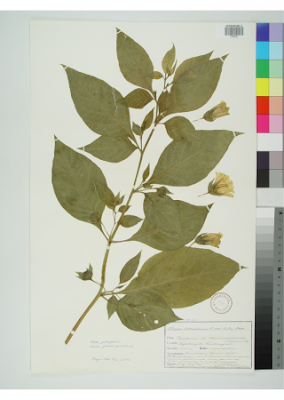Look at one of the most poisonous plants in Europe - deadly nightshade (Atropa belladonna). Did you know that in the early and middle ages, women of all ages rubbed belladonna juice into their eyes to make them large and beautiful, from which also comes the species name of the plant (bella donna = beautiful woman)?
 |
| Atropa belladonna from Europeana (image is under CC-BY-SA, from Biologiezentrum der Oberoesterreichen Landesmuseen) |
Deadly nightshade is massive 50-180 cm tall shrub with dark purple bell-shaped flowers. The pods are shiny black berries the size of a cherry. Nightshade grows in well-lit forests all over Europe, diminishing northwards. This plant belongs to the Solenaceae family, as do the potato and tomato. All parts of the plant are poisonous, and contain tropane alkaloids.
Nightshade's principal danger lies in that its berries are very pretty and look edible, have a pleasantly sweet taste, and are at eye level for children, to whom they look like overripe cherries. Two to four berries are a fatal dose for a child, an adult needs ten to twenty. The most poisonous part of the plant is the root, but the consumption of even a single leaf can be fatal for an adult. Symptoms are initially a red face, dry mouth, dilated pupils and quickened pulse; in later stages, heart arrhythmia, tremors, hallucinations, paranoia and cramping.
 |
| Atropa belladonna from BHL |
This plant is widely used in medicine. Nightshade is an ingredient in atropine drops, used in ophthalmology, because atropine dilates the pupils. Extract from nightshade leaves is also used in analgesics to counteract cramps of smooth muscle tissue (antispasmodic). For more information see BLE Poisonous Nature. Stay tuned!


